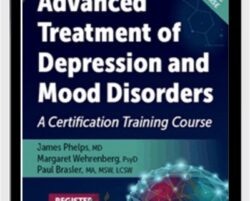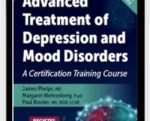Be more confident diagnosing mood disorders, reduce the risk of suicide and self-harm & help your clients live more joyfullyIf you want to use leading-edge research to master successful clinical diagnoses so your clients get the treatment they need to thrive … then this is going to be the most important message you read all day. Here’s why …Between pure depression and Bipolar I lies a complex landscape of “mid-spectrum diagnoses,” including Bipolar II. The DSM has yet to fully recognize this spectrum of mood disorders. It still classifies depression and bipolar disorders as separate illnesses …… Which contributes to the misdiagnosis of as many as 69% of bipolar disorder cases. More than one-third of these people remain misdiagnosed for 10 years or more. Mood disorder misinformation can have serious consequences for clients, including increased risk of suicide and self-harm.According to the Archives of General Psychiatry, “Inappropriate treatment of bipolar disorder [BPD] is a serious problem in the U.S. population. Sub-threshold BPD is commonly occurring, clinically significant, and under-detected in treatment settings.”To help you clear these hurdles to accurate diagnosis, we’ve created this exclusive, depression and mood disorder online training course. It will help you treat these conditions properly, and reduce the risk of client suicide.What You’ll Discover In This Certification TrainingPART ONE: Bipolar Disorders: Essentials for Clinical Practice with James Phelps, M.D.MODULE I: Understanding the Complexities of Diagnosing Bipolar Disorder: Spectrum and DSM approachesMnemonic devices to help remember the clusters of symptoms that make up a bipolar diagnosisHypomania and how it differs from maniaUsing the MoodCheck tool, Bipolarity Index and non-manic bipolar markers such as family history and response to medication to recognize bipolarityAn overview of the effectiveness—and limitations—of brain imaging tools in diagnosing bipolar disorderMODULE II: What Causes Bipolar Disorder and An Overview of Treatment OptionsExploring genetics, gut inflammation, circadian stress, hormones and traumaDetermining what is bipolar disorder vs. depression, addictions or ADHDBipolar-specific psychotherapy: recommended modalities and toolsUsing sleep rhythm, social rhythm and light and darkness as therapeutic toolsMODULE III: Medication Options and Implementing Bipolar Disorder TreatmentMedications that can—and cannot—treat bipolar disorders: Risk factors, benefits and how to effectively add useful meds to a treatment planHow to use the “consultation to the client” model to help your clients taper off antidepressant medicationAn overview of a treatment plan that can help you implement this therapy in your practiceGet Advanced Treatment of Depression and Mood Disorders: A Certification Training Course – James Phelps & Others, Only Price $79PART TWO: The 10 Best-Ever Depression Management Techniques: Managing Depression across the Lifespan, Raising Energy and Improving Cognition with Margaret Wehrenberg, Psy.D.MODULE I: Understanding the Sources and Symptoms of DepressionCore symptoms of depression you’ll likely encounter with clientsMultiple causes of depressionBipolar disorder spectrum and depressionThe importance of self-care in managing depression—and great ways to practice itThe role of medicationsIdentifying depression triggers and ways to counteract themMODULE II: Helping Your Clients Participate in Their Own HealingHow to engage the client in their sessions and habit buildingHow to help your clients replace negative thinking and habits with positive onesHelping clients to mobilize their energy to overcome lethargyHelping your clients to move out of isolation and engage in REAL social situations and friendships, not only social mediaMODULE III: How to Help Your Clients Balance Their LivesWhat your clients can do to start feeling more positive and balanced in their livesHelping your clients overcome perfectionism and increase self-compassionTools and processes for stopping destructive behaviorMODULE IV: Increasing Emotional Flexibility to Allow for More PositivityDeveloping interventions for bad moodsHow to reframe negative experiences to manage disappointment and reduce catastrophizingHow to help your clients develop a tolerance for hopeCultivating a gratitude practice as part of helping your clients savor lifePART THREE: Suicide Assessment and Intervention: Today’s Top Challenges for Mental Health Professionals with Paul Brasler, MA, MSW, LCSWMODULE I: Laying the Groundwork for Understanding SuicideWhy people choose suicideIdentifying risk factorsHow to identify protective factors for suicideMODULE II: Creating a Solid Suicide Assessment SystemTypes of suicidal ideation and intentTwo important things you must do before working with clientsHow to identify implicit suicidal intentOpen-ended questions to ask to build the client-clinician relationshipThe importance of documentation: protect your clients (and your license)MODULE III: Suicide Intervention StrategiesAssessing a client’s suicide dispositionKnowing when to hospitalize—and how to ensure their safety once thereWhy “contracting for safety” is an outdated and potentially dangerous, clinical tool (and what to do instead)Effective medications and treatments in reducing the risk of suicideTools, processes and modalities you can use to improve outcomes with clients after the initial crisis has passedHow to assess and treat non-suicidal self-injury (such as cutting) and other self-injurious behaviorsMODULE IV: The Connections Between Suicide, Mental Illness and TraumaDepressive, bipolar and psychotic disordersPersonality disordersSubstance use disordersSuicide clusters and pactsHomicide-suicideAssessing threats of future violence or homicideMODULE V: Tips for Managing Our Anxiety as CliniciansThe importance of self-careSelf-care activities that can help reduce the risk of compassion fatigue or burnoutRecognizing what you can control—and what’s out of your controlThe value of debriefing and peer supervisionGet Advanced Treatment of Depression and Mood Disorders: A Certification Training Course – James Phelps & Others, Only Price $79Register today and get three FREE Bonus items Bonus 1: Digital Seminar | 15 Must-Have Mindfulness Techniques for Clinicians: Skills to Transform Your Treatment Plans for Stress, Depression, Anxiety, Anger, Trauma, Guilt and ShamePresented by Terry Fralich, LCPC (a $219.99 value)You’ll discover how to:Motivate clients to engage in treatment with easy-to-follow explanations of how mindfulness can affect these processesUse mindfulness practices in therapy to impact the stress reaction and shift clients to a relaxation responseIncorporate mindfulness interventions into your treatment plans for depression and anxiety that can counter automatic patterns of thoughtsTeach mindfulness and calming breathing techniques in-session to help clients manage their angered outburstsCalm the traumatized brain with grounding techniques and breathing exercisesAppraise the clinical utility of mindfulness-based therapies in regulating shame and guilt In addition, Terry gives you detailed instruction on his top mindfulness interventions to help your clients deal with guilt and shame and empower them to manage their anger and toxic emotions.Bonus 2: PDF Workbook | The Depression and Bipolar Workbook: 30 Ways to Lift Your Mood & Strengthen the BrainBy Chris Aiken, MD (a $29.99 value)Learn how to recognize unique symptoms of depression and bipolar and match them with the latest advances in CBT, light and dark therapy, diet and sleep techniques, and strategies to fix out-of-sync biological clocks. You’ll discover:Strategies to feel energized, lift mood and stay focusedA sleep plan that doubles the effects of antidepressantsMood stabilizing interventions for morning, day and nightAdvanced treatment planning for insomniaReproducible handouts, worksheets and chartsAnd so much more! This workbook will help you give your clients the tools they need to effectively manage depression and bipolar disorder.Bonus 3: PDF Book | High Risk Clients: Evidence-based Assessment & Clinical Tools to Recognize and Effectively Respond to Mental Health CrisesBy Paul Brasler, MA, MSW, LCSW (a $29.99 value)High Risk Clients provides a comprehensive, concise resource that you’ll turn to time after time to effectively intervene and keep clients safe: Recognize medical emergencies that present with psychological symptomsSuicide assessment and minimizing risk with realistic safety planningTools and treatment protocols for substance abuseStrategies for trauma-informed carePrepare for the risk of violent behaviorDownloadable assessments and handoutsPractice case studiesAnd much more! This book will help you manage your more volatile clients and reduce the number of crises.Get Advanced Treatment of Depression and Mood Disorders: A Certification Training Course – James Phelps & Others, Only Price $79Tag: Advanced Treatment of Depression and Mood Disorders: A Certification Training Course – James Phelps & Others Review. Advanced Treatment of Depression and Mood Disorders: A Certification Training Course – James Phelps & Others download. Advanced Treatment of Depression and Mood Disorders: A Certification Training Course – James Phelps & Others discount.
 Quick Sprout Traffic System – Neil Patel
₹7,138.00
Quick Sprout Traffic System – Neil Patel
₹7,138.00
 The Content Creator Workshop – Wolves Workshops
₹3,818.00
The Content Creator Workshop – Wolves Workshops
₹3,818.00
Advanced Treatment of Depression and Mood Disorders: A Certification Training Course – James Phelps & Others
₹12,450.00




